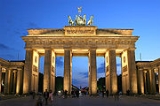
Brandenburg Gate
Encyclopedia
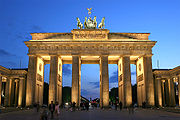
City gate
A city gate is a gate which is, or was, set within a city wall. Other terms include port.-Uses:City gates were traditionally built to provide a point of controlled access to and departure from a walled city for people, vehicles, goods and animals...
and one of the most well-known landmarks of Berlin and Germany. It is located west of the city centre at the junction of Unter den Linden
Unter den Linden
Unter den Linden is a boulevard in the Mitte district of Berlin, the capital of Germany. It is named for its linden trees that line the grassed pedestrian mall between two carriageways....
and Ebertstraße, immediately west of the Pariser Platz
Pariser Platz
Pariser Platz is a square in the centre of Berlin, Germany, situated by the Brandenburg Gate at the end of the Unter den Linden. The square is named after the French capital Paris in honour of the Allied occupation of Paris in 1814, and is one of the main focal points of the city.-History :Pariser...
. It is the only remaining gate of a series through which Berlin was once entered. One block to the north stands the Reichstag building. The gate is the monumental entry to Unter den Linden
Unter den Linden
Unter den Linden is a boulevard in the Mitte district of Berlin, the capital of Germany. It is named for its linden trees that line the grassed pedestrian mall between two carriageways....
, the renowned boulevard of linden
Tilia
Tilia is a genus of about 30 species of trees native throughout most of the temperate Northern Hemisphere. The greatest species diversity is found in Asia, and the genus also occurs in Europe and eastern North America, but not western North America...
trees which formerly led directly to the city palace of the Prussia
Prussia
Prussia was a German kingdom and historic state originating out of the Duchy of Prussia and the Margraviate of Brandenburg. For centuries, the House of Hohenzollern ruled Prussia, successfully expanding its size by way of an unusually well-organized and effective army. Prussia shaped the history...
n monarchs. It was commissioned by King Frederick William II of Prussia
Frederick William II of Prussia
Frederick William II was the King of Prussia, reigning from 1786 until his death. He was in personal union the Prince-Elector of Brandenburg and the sovereign prince of the Principality of Neuchâtel.-Early life:...
as a sign of peace and built by Carl Gotthard Langhans
Carl Gotthard Langhans
Carl Gotthard Langhans was a Prussian builder and architect. His works are among the earliest buildings in the German classicism movement. His best-known work is the Brandenburg Gate in Berlin.- Life :...
from 1788 to 1791. Having suffered considerable damage in World War II, the Brandenburg Gate was fully restored from 2000 to 2002 by the Stiftung Denkmalschutz Berlin (Berlin Monument Conservation Foundation).
Design and history

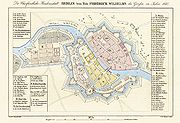
Frederick William I of Prussia
Frederick William I of the House of Hohenzollern, was the King in Prussia and Elector of Brandenburg from 1713 until his death...
(1688), shortly after the Thirty Years' war
Thirty Years' War
The Thirty Years' War was fought primarily in what is now Germany, and at various points involved most countries in Europe. It was one of the most destructive conflicts in European history....
and a century before the gate was constructed, Berlin was a small walled city within a star fort
Star fort
A star fort, or trace italienne, is a fortification in the style that evolved during the age of gunpowder, when cannon came to dominate the battlefield, and was first seen in the mid-15th century in Italy....
with several named gates: Spandau
Spandau
Spandau is the fifth of the twelve boroughs of Berlin. It is the fourth largest and westernmost borough, situated at the confluence of the Havel and Spree rivers and along the western bank of the Havel, but the least populated.-Overview:...
er Tor, St. Georgen Tor, Stralower Tor, Cöpenicker
Köpenick
Köpenick is a historic town and locality that is situated at the confluence of the rivers Dahme and Spree in the south-east of the German capital city of Berlin. It was formerly known as Copanic and then Cöpenick, only officially adopting the current spelling in 1931...
Tor, Neues Tor, and Leipzig
Leipzig
Leipzig Leipzig has always been a trade city, situated during the time of the Holy Roman Empire at the intersection of the Via Regia and Via Imperii, two important trade routes. At one time, Leipzig was one of the major European centres of learning and culture in fields such as music and publishing...
er Tor (see map). Relative peace, a policy of religious tolerance, and status as capital of the Kingdom of Prussia
Kingdom of Prussia
The Kingdom of Prussia was a German kingdom from 1701 to 1918. Until the defeat of Germany in World War I, it comprised almost two-thirds of the area of the German Empire...
facilitated the growth of the city.
The Brandenburg Gate was not part of the old fortifications but one of 18 gates within the fiscal excise
Excise
Excise tax in the United States is a indirect tax on listed items. Excise taxes can be and are made by federal, state and local governments and are far from uniform throughout the United States...
wall , erected in the 1730s, including the old fortified city and many of its then suburbs.
The Brandenburg Gate was commisioned by Friedrich Wilhelm II
Frederick William II of Prussia
Frederick William II was the King of Prussia, reigning from 1786 until his death. He was in personal union the Prince-Elector of Brandenburg and the sovereign prince of the Principality of Neuchâtel.-Early life:...
to represent peace. The Gate was designed by Carl Gotthard Langhans
Carl Gotthard Langhans
Carl Gotthard Langhans was a Prussian builder and architect. His works are among the earliest buildings in the German classicism movement. His best-known work is the Brandenburg Gate in Berlin.- Life :...
, the Court Superintendent of Buildings. Between 1788 and 1791 the prior simple guard houses siding the gate were replaced by the current construction. The Gate consists of twelve Doric
Doric order
The Doric order was one of the three orders or organizational systems of ancient Greek or classical architecture; the other two canonical orders were the Ionic and the Corinthian.-History:...
columns, six to each side, forming five passageways. Citizens originally were allowed to use only the outermost two. Atop the gate is the Quadriga
Quadriga
A quadriga is a car or chariot drawn by four horses abreast . It was raced in the Ancient Olympic Games and other contests. It is represented in profile as the chariot of gods and heroes on Greek vases and in bas-relief. The quadriga was adopted in ancient Roman chariot racing...
, a chariot drawn by four horses driven by Victoria
Victoria (mythology)
In ancient Roman religion, Victoria was the personified goddess of victory. She is the Roman equivalent of the Greek goddess Nike, and was associated with Bellona. She was adapted from the Sabine agricultural goddess Vacuna and had a temple on the Palatine Hill...
, the Roman goddess of victory.
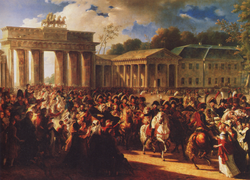
Propylaea
A Propylaea, Propylea or Propylaia is any monumental gateway based on the original Propylaea that serves as the entrance to the Acropolis in Athens...
, the gateway to the Acropolis
Acropolis
Acropolis means "high city" in Greek, literally city on the extremity and is usually translated into English as Citadel . For purposes of defense, early people naturally chose elevated ground to build a new settlement, frequently a hill with precipitous sides...
in Athens
Athens
Athens , is the capital and largest city of Greece. Athens dominates the Attica region and is one of the world's oldest cities, as its recorded history spans around 3,400 years. Classical Athens was a powerful city-state...
, Greece and is consistent with Berlin's history of architectural classicism
Classicism
Classicism, in the arts, refers generally to a high regard for classical antiquity, as setting standards for taste which the classicists seek to emulate. The art of classicism typically seeks to be formal and restrained: of the Discobolus Sir Kenneth Clark observed, "if we object to his restraint...
(first, Baroque
Baroque
The Baroque is a period and the style that used exaggerated motion and clear, easily interpreted detail to produce drama, tension, exuberance, and grandeur in sculpture, painting, literature, dance, and music...
, and then neo-Palladian). The Gate was the first "Athens on the River Spree" by architect Carl Gotthard von Langhans. The capital Quadriga was sculpted by Johann Gottfried Schadow
Johann Gottfried Schadow
Johann Gottfried Schadow was a German sculptor.-Biography:Schadow was born in Berlin, where his father was a poor tailor....
.
The Brandenburg Gate's design has remained essentially unchanged since its completion even as it has played different political roles in German history. After the 1806 Prussian defeat at the Battle of Jena-Auerstedt
Battle of Jena-Auerstedt
The twin battles of Jena and Auerstedt were fought on 14 October 1806 on the plateau west of the river Saale in today's Germany, between the forces of Napoleon I of France and Frederick William III of Prussia...
, Napoleon took the Quadriga to Paris.
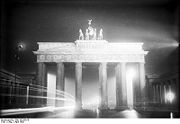
Ernst von Pfuel
Ernst Heinrich Adolf von Pfuel was a Prussian general.Pfuel was born in Jahnsfelde , Brandenburg. He served as commander of the Prussian sector of Paris from 1814-1815 during the Napoleonic Wars...
, the Quadriga was restored to Berlin and Victoria's wreath of oak leaves was supplemented with a new symbol of Prussian power, the Iron Cross
Iron Cross
The Iron Cross is a cross symbol typically in black with a white or silver outline that originated after 1219 when the Kingdom of Jerusalem granted the Teutonic Order the right to combine the Teutonic Black Cross placed above a silver Cross of Jerusalem....
. The Quadriga faces east, as it did when it was originally installed in 1793. Only the royal family was allowed to pass through the central archway, as well as members of the Pfuel
Pfuel
The German ancient noble family of Pfuel arrived in Brandenburg in the year 926 and later widened their influence to Saxony, Mecklenburg, Pomerania, Württemberg, Westphalia, Eastern Europe and Sweden....
family, from 1814 to 1919. In addition, the central archway was also used by the coaches of Ambassadors on the single occasion of their presenting their letters of credence to the monarch.
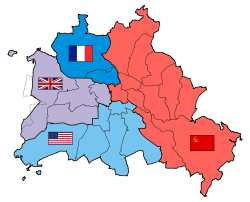
East Berlin
East Berlin was the name given to the eastern part of Berlin between 1949 and 1990. It consisted of the Soviet sector of Berlin that was established in 1945. The American, British and French sectors became West Berlin, a part strongly associated with West Germany but a free city...
and West Berlin
West Berlin
West Berlin was a political exclave that existed between 1949 and 1990. It comprised the western regions of Berlin, which were bordered by East Berlin and parts of East Germany. West Berlin consisted of the American, British, and French occupation sectors, which had been established in 1945...
restored it in a joint effort. The holes were patched, and were visible for many years following the war.
In 1990, the Quadriga was removed from the gate as part of renovation work carried out by the East German authorities.
On December 21, 2000, the Brandenburg Gate was privately refurbished at a cost of six million dollars (U.S.).
On October 3, 2002, the twelfth anniversary of German Reunification
German reunification
German reunification was the process in 1990 in which the German Democratic Republic joined the Federal Republic of Germany , and when Berlin reunited into a single city, as provided by its then Grundgesetz constitution Article 23. The start of this process is commonly referred by Germans as die...
, the Brandenburg Gate was once again reopened following extensive refurbishment.
The Brandenburg Gate is now again closed for vehicle traffic, and much of Pariser Platz has been turned into a cobblestone
Cobblestone
Cobblestones are stones that were frequently used in the pavement of early streets. "Cobblestone" is derived from the very old English word "cob", which had a wide range of meanings, one of which was "rounded lump" with overtones of large size...
pedestrian zone.
Berlin Wall and its fall
Vehicles and pedestrians could travel freely through the gate, located in East BerlinEast Berlin
East Berlin was the name given to the eastern part of Berlin between 1949 and 1990. It consisted of the Soviet sector of Berlin that was established in 1945. The American, British and French sectors became West Berlin, a part strongly associated with West Germany but a free city...
, until the Berlin Wall
Berlin Wall
The Berlin Wall was a barrier constructed by the German Democratic Republic starting on 13 August 1961, that completely cut off West Berlin from surrounding East Germany and from East Berlin...
was built, 13 August 1961. Then one of altogether eight Berlin Wall crossings
Berlin border crossings
The Berlin border crossings were created as a result of the postwar division of Germany. Prior to the construction of the Berlin Wall in 1961, travel between the Eastern and Western sectors of Berlin was totally uncontrolled, although restrictions were increasingly introduced by the Soviet and East...
was opened on the eastern side of the gate, usually not open for East Berliners and East Germans, who from then on needed a hard-to-obtain exit visa. On 14 August West Berliners gathered on the western side of the gate to demonstrate against the Berlin Wall, among them West Berlin's governing Mayor Willy Brandt
Willy Brandt
Willy Brandt, born Herbert Ernst Karl Frahm , was a German politician, Mayor of West Berlin 1957–1966, Chancellor of West Germany 1969–1974, and leader of the Social Democratic Party of Germany 1964–1987....
, who had spontaneously returned from a federal election campaigning tour in West Germany earlier on the same day.
Under the pretext that Western demonstrations required it, the East closed the checkpoint at the Brandenburg Gate the same day, 'until further notice', a situation that was to last until 22 December 1989. The Wall was erected as an arc just west of the gate, cutting off access from West Berlin. On the eastern side, the "baby Wall", drawn across the eastern end of Pariser Platz
Pariser Platz
Pariser Platz is a square in the centre of Berlin, Germany, situated by the Brandenburg Gate at the end of the Unter den Linden. The square is named after the French capital Paris in honour of the Allied occupation of Paris in 1814, and is one of the main focal points of the city.-History :Pariser...
rendered it off limits to East Berliners as well.
When the Revolutions of 1989
Revolutions of 1989
The Revolutions of 1989 were the revolutions which overthrew the communist regimes in various Central and Eastern European countries.The events began in Poland in 1989, and continued in Hungary, East Germany, Bulgaria, Czechoslovakia and...
occurred and the Wall fell, the gate symbolized freedom and the desire to unify the city of Berlin. Thousands of people gathered at the Wall to celebrate its fall on 9 November 1989. On 22 December 1989, the Brandenburg Gate crossing
Berlin border crossings
The Berlin border crossings were created as a result of the postwar division of Germany. Prior to the construction of the Berlin Wall in 1961, travel between the Eastern and Western sectors of Berlin was totally uncontrolled, although restrictions were increasingly introduced by the Soviet and East...
was reopened when Helmut Kohl
Helmut Kohl
Helmut Josef Michael Kohl is a German conservative politician and statesman. He was Chancellor of Germany from 1982 to 1998 and the chairman of the Christian Democratic Union from 1973 to 1998...
, the West German chancellor, walked through to be greeted by Hans Modrow
Hans Modrow
Hans Modrow is a German politician, best known as the last communist premier of East Germany. He currently is the honorary Chairman of the Left Party....
, the East German prime minister. Demolition of the rest of the Wall around the area took place the following year.
Brandenburg Gate became the main venue for the 20th anniversary celebrations of the fall of the Berlin Wall or "Festival of Freedom" on the evening of 9 November 2009. The high point of the celebrations was when over 1000 colorfully designed foam domino tiles, each over 2.5 meters tall, were lined up along the route of the former wall through the city centre. The domino "wall" was then toppled in stages converging here.
Political history at the gate
A Soviet flag flew from a flagpole atop the gate from 1945 until 1957, when it was replaced by an East German flag. Since the reunification of Germany, the flag and the pole have been removed.In 1963, U.S. President John F. Kennedy
John F. Kennedy
John Fitzgerald "Jack" Kennedy , often referred to by his initials JFK, was the 35th President of the United States, serving from 1961 until his assassination in 1963....
visited the Brandenburg Gate. The Soviets hung large red banners across it to prevent him looking into the East. In the 1980s, decrying the existence of two German states, West Berlin mayor Richard von Weizsäcker
Richard von Weizsäcker
Richard Karl Freiherr von Weizsäcker , known as Richard von Weizsäcker, is a German politician . He served as Governing Mayor of West Berlin from 1981 to 1984, and as President of the Federal Republic of Germany from 1984 to 1994...
said: "The German question is open as long as the Brandenburg Gate is closed."
On June 12, 1987, U.S. President Ronald Reagan
Ronald Reagan
Ronald Wilson Reagan was the 40th President of the United States , the 33rd Governor of California and, prior to that, a radio, film and television actor....
spoke to the West Berlin
West Berlin
West Berlin was a political exclave that existed between 1949 and 1990. It comprised the western regions of Berlin, which were bordered by East Berlin and parts of East Germany. West Berlin consisted of the American, British, and French occupation sectors, which had been established in 1945...
populace at the Brandenburg Gate, demanding the razing of the Berlin Wall. Addressing CPSU
Communist Party of the Soviet Union
The Communist Party of the Soviet Union was the only legal, ruling political party in the Soviet Union and one of the largest communist organizations in the world...
General Secretary Mikhail Gorbachev
Mikhail Gorbachev
Mikhail Sergeyevich Gorbachev is a former Soviet statesman, having served as General Secretary of the Communist Party of the Soviet Union from 1985 until 1991, and as the last head of state of the USSR, having served from 1988 until its dissolution in 1991...
, Reagan said,
On July 12, 1994, U.S. President Bill Clinton
Bill Clinton
William Jefferson "Bill" Clinton is an American politician who served as the 42nd President of the United States from 1993 to 2001. Inaugurated at age 46, he was the third-youngest president. He took office at the end of the Cold War, and was the first president of the baby boomer generation...
spoke at the Gate about peace in post–Cold War Europe.
On November 9, 2009, Chancellor of Germany, Angela Merkel
Angela Merkel
Angela Dorothea Merkel is the current Chancellor of Germany . Merkel, elected to the Bundestag from Mecklenburg-Vorpommern, has been the chairwoman of the Christian Democratic Union since 2000, and chairwoman of the CDU-CSU parliamentary coalition from 2002 to 2005.From 2005 to 2009 she led a...
, walked through Brandenburg Gate with Russia’s Mikhail Gorbachev
Mikhail Gorbachev
Mikhail Sergeyevich Gorbachev is a former Soviet statesman, having served as General Secretary of the Communist Party of the Soviet Union from 1985 until 1991, and as the last head of state of the USSR, having served from 1988 until its dissolution in 1991...
and Poland's Lech Wałęsa
Lech Wałęsa
Lech Wałęsa is a Polish politician, trade-union organizer, and human-rights activist. A charismatic leader, he co-founded Solidarity , the Soviet bloc's first independent trade union, won the Nobel Peace Prize in 1983, and served as President of Poland between 1990 and 95.Wałęsa was an electrician...
as part of the 20-year celebration of tearing down the Berlin Wall.
On August 13, 2011, Germany marked the 50th anniversary of the day the Berlin Wall
Berlin Wall
The Berlin Wall was a barrier constructed by the German Democratic Republic starting on 13 August 1961, that completely cut off West Berlin from surrounding East Germany and from East Berlin...
started to go up with a memorial service and a minute of silence in memory of those who died trying to flee to the West. "It is our shared responsibility to keep the memory alive and to pass it on to the coming generations as a reminder to stand up for freedom and democracy to ensure that such injustice may never happen again," Berlin Mayor Klaus Wowereit
Klaus Wowereit
Klaus Wowereit is a German politician, member of the SPD , and has been the Mayor of Berlin since the 2001 state elections, where his party won a plurality of the votes, 29.7%. He served as President of the Bundesrat in 2001/02. His SPD-led coalition was re-elected in the 2006 elections...
said. German Chancellor Angela Merkel
Angela Merkel
Angela Dorothea Merkel is the current Chancellor of Germany . Merkel, elected to the Bundestag from Mecklenburg-Vorpommern, has been the chairwoman of the Christian Democratic Union since 2000, and chairwoman of the CDU-CSU parliamentary coalition from 2002 to 2005.From 2005 to 2009 she led a...
—who grew up behind the wall in Germany's communist eastern part—also attended the commemoration. German President Christian Wulff
Christian Wulff
Christian Wilhelm Walter Wulff is the President of Germany and a politician of the Christian Democratic Union. He was elected President on 2010 and publicly swore the oath of office on . A lawyer by profession, he served as Premier of the state of Lower Saxony from 2003 to 2010.-Early life and...
added, "It has been shown once again: Freedom is invincible at the end. No wall can permanently withstand the desire for freedom."
External links
- Stiftung Denkmalschutz Berlin (Berlin Monument Conservation Foundation)
- Brandenburg Gate described in its historic context.
- Panorama Brandenburg Gate - Panoramic view from the Pariser Platz
- Webcam: Live-View of the Street "Unter den Linden" with Brandenburg Gate in Berlin, Germany
- Ronald Reagan's Tear this Wall speech
- Complete text, audio and video of Ronald Reagan's Brandenburg Gate Address from AmericanRhetoric.com
- Bill Clinton's Berlin is free speech
- Video News report of the Brandenburg Gate re-opening - Real Player needed
- Germany, Berlin, Brandenburger Tor Virtual tour with map and compass effect by Tolomeus
- Panorama Brandenburg Gate 1945 - Panoramic view into the past, 60 years after WWII
- Celebrating 20 years after tearing down the Berlin wall, 1989 - Pictures at Brandenburg Gate on November 9, 2009
- Three-dimensional view of Brandenburger Gate (without plugin English, German, Spanish)

